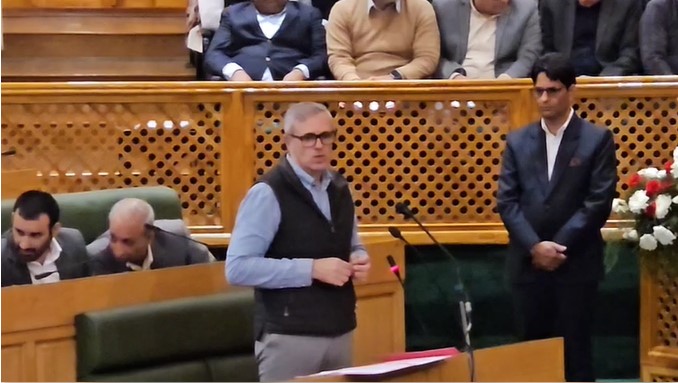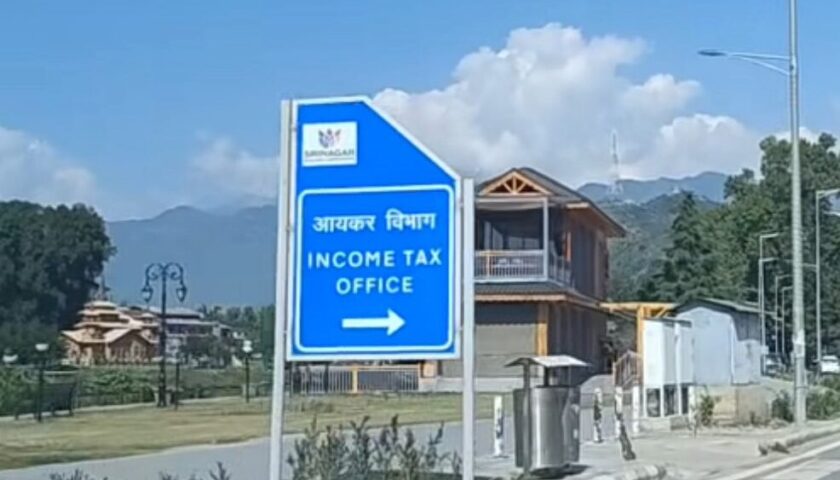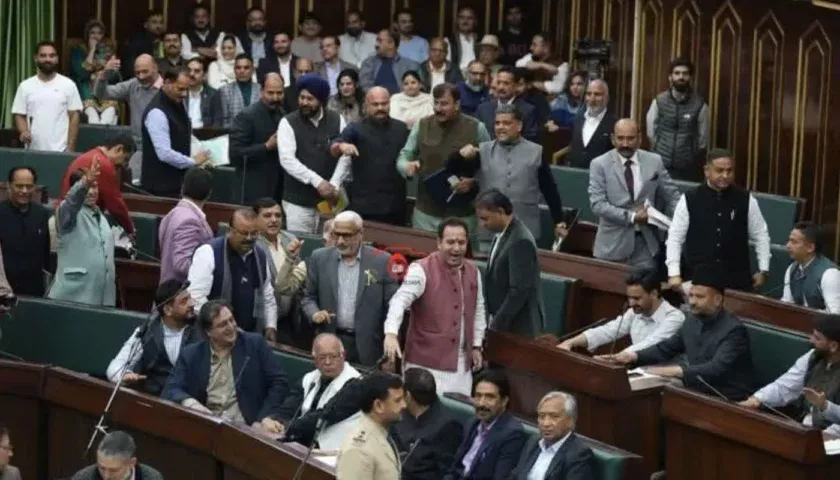Landlines and Lifelines: Who Owns Kashmir’s Shelter Rights?
By: Javid Amin | 28 October 2025
In the autumn session of the Jammu & Kashmir Legislative Assembly (J&K LA), a private member’s bill stirred a vortex of legal, political and human-rights issues. Moved by Waheed ur Rehman Para of the People’s Democratic Party (PDP), the legislation sought to grant ownership rights to residents who have built homes on government land—State land, ‘kacharai’ land, common land and ‘shamilat’ land.
But the bill was rejected by the ruling coalition in the Assembly, led by Omar Abdullah of the Jammu & Kashmir National Conference (NC), who called it a dangerous precedent that would legitimise land grabbing.
At stake are more than legal technicalities. This is about the right to a roof, dignity of long-settled families, the trust in public institutions and the integrity of land governance in a region where land and identity are intimately intertwined. In this article, we explore the context, the arguments, the implications—legal, social and political—and why this rejection matters for Kashmir’s future.
What the Bill Proposed
01. The basic contours
The proposed bill, entitled “A Bill to Provide Special Provisions for the Residents of the Union Territory of Jammu & Kashmir” (moved in 2025), aimed to:
-
Recognise proprietary rights for residents who have constructed homes on lands classified as State land, kacharai (grazing or marginal lands), common land or shamilat land.
-
Invoke the right to shelter under Article 21 of the Indian Constitution — which guarantees the right to life and personal liberty — as a foundational principle for such recognition.
-
Frame the move as one of social justice, not as a reward for encroachment. The PDP argued that many of these families have lived on these lands for decades, often without formal titles, vulnerable to eviction.
-
Draw inspiration from the historical “Land to the Tiller” reforms of Sheikh Mohammad Abdullah — the idea being to bring dignity, formal entitlement and settlement to long-settled occupants.
02. The specific beneficiaries and provisions
As per the bill’s text (summarised in reports):
-
It targeted residential houses built on the specified lands, and sought to enable ownership or transfer rights in favour of the occupant-residents.
-
It emphasised continuous possession or ownership by residents, sometimes for long spells (decades) without formal title, facing eviction threats or demolition of homes.
-
It emphasised vulnerable categories: the poor, disabled, long-settled families whose lives were disrupted by looming bulldozer drives and lack of legal protection.
03. The rationale from the PDP side
From the PDP’s viewpoint:
-
These residents lacked formal titles but had built their lives, homes and neighbourhoods on lands that the state had not reclaimed and which were often quasi-settled in practice.
-
Post the abrogation of Article 370 and other constitutional changes, there was heightened insecurity among those occupying such land, making regularisation a matter of dignity, rights and stability.
-
The bill was positioned not as an encouragement of illegal occupation but as recognition of de facto realities — long-standing homes, families, communities — while trying to bring them into a legal framework.
-
The invocation of Article 21 served to connect the right to shelter and dignity with entitlements to land/security.
04. Legal and conceptual background
-
The agrarian and land laws in J&K (such as the J&K Agrarian Reforms Act, 1976) classify certain lands as common land, shamilat, etc., which have special status and restrictions. The bill sought to address houses built on such lands.
-
A prior landmark scheme, the J&K State Lands (Vesting of Ownership to the Occupants) Act, 2001 — popularly the “Roshni Scheme” — attempted to convert certain leasehold rights into freehold in return for revenue; but it later faced severe legal challenge and was declared unconstitutional in parts.
-
Thus, the bill tried to navigate between socio-legal realities (de facto settlement, rights of occupants) and the legal frameworks for land ownership and public land protection.
Why the Assembly Rejected It
01. Government’s objections
The motion was strongly opposed by Chief Minister Omar Abdullah and the NC-BJP alliance in the Assembly. Their main arguments included:
-
Granting ownership to people who built homes on government land without a legal basis would amount to legalising encroachments. The CM said the government cannot accept such a bill.
-
It would set a precedent where any individual could occupy State land, build a house, and claim ownership tomorrow — opening floodgates for land grabbing and misuse of public land.
-
They pointed to the problematic history of the Roshni-Act scheme, where conversions of land rights became controversial, subject to court rulings and allegations of corruption. The CM drew a direct parallel.
-
The government argued that there already exist other schemes like the Pradhan Mantri Awas Yojana (PMAY) to provide housing or land to the landless, and that overriding the land laws wholesale was not legally feasible.
02. Political and ideological objections
-
The opposition (from the NC/BJP side) argued that the bill potentially risked demographic change and might dilute land-rights dynamics in J&K. For instance, the BJP labelled it a part of “land jihad” (their term) and a threat to the integrity of land laws.
-
The NC insisted that historical land-reforms such as “Land to the Tiller” were about agrarian rights to tillers, not about legitimising mass occupation of government land or bypassing land laws.
-
Some accused the PDP of using the bill for political mileage, especially in the valley, evoking emotive slogans about protection from bulldozer drives. The government retorted that this was populism, not lawful policy.
03. The vote and outcome
-
When put to a voice vote in the Assembly, the bill received overwhelmingly negative support: only three votes in favour (including the proposer, Waheed Para) and was rejected.
-
The Speaker asked if the bill should be admitted for detailed discussion; with such low support it was dropped.
-
PDP leaders publicly accused the government of betraying the people and reneging on promises made about land and shelter rights.
The Broader Debate: Welfare vs Rule-of-Law
This episode is symptomatic of a deeper tension in Jammu & Kashmir: the push for social justice and regularisation of de facto realities, versus the imperative to maintain rule of law, protect public land and prevent misuse of land rights.
01. The human justice argument
-
Many families in J&K have been residing for decades on lands without formal title. They built homes, raised children, developed communities — yet face the risk of eviction, demolition, uncertainty. The bill sought to give them legal protection and dignity.
-
In a region where land and identity are deeply connected, the right to shelter becomes a matter of civil dignity, social stability and trust in the state.
-
From a policy perspective, formalising long-settled rights can improve security of tenure, allow households to invest in homes, access credit, and reduce fear of eviction.
02. The legal-governance argument
-
Government lands, common lands, grazing lands and shamilat lands are held under special regimes in J&K. Misclassification, encroachment and illegal occupation have been longstanding challenges. Granting ownership to occupants without strong safeguards threatens public interest.
-
The history of the Roshni Scheme illustrates the risks: alleged large-scale misuse, legal invalidation by courts, massive public losses.
-
Loosening rules for proprietary rights can incentivise further encroachments, weakening institutional land governance and undermining confidence in revenue, forest, grazing and communal land regimes.
-
The government argues that any regularisation must be selective, legally sound, transparent, and mindful of the broader land-use balance. A sweeping blanket law is risky.
03. The political-social faultlines
-
Jammu & Kashmir is not just geopolitically contested — it is socially and economically distinct. Issues of domicile, land rights, demographic balance, post-2019 reorganisation anxieties all feed into land policy debates.
-
The bill became a flashpoint: to some, it was a necessary rectification of long-standing injustice; to others it was a soft door to “land grab” and demographic engineering.
-
The invocation of emotive terms like “bulldozer drives”, “anti-encroachment”, “land jihad”, show how charged the issue is. The trust deficit between state and society amplifies each initiative’s risk and resonance.
-
For the PDP, the bill was a political message — stand for the vulnerable, attacked by bulldozers and without legal title. For the NC/BJP government, rejection was a statement of law-and-order and safeguarding public land.
Historical Context and Land Regimes in J&K
To understand why this debate is so intense, we must trace the history of land reforms, ownership laws and land-settlement practices in J&K.
01. Agrarian reforms and “Land to the Tiller”
-
In the late 1940s and 1950s, under Sheikh Mohammad Abdullah’s leadership, J&K introduced agrarian reforms that sought to transfer land rights to tillers, abolish intermediaries and strengthen peasant rights. This legacy remains politically significant.
-
The agrarian reforms emphasised giving land to those who actually cultivated it — a distinct purpose from regularising homes built on government land. The current bill’s proponents sought to link back to that legacy, while opponents rejected the analogy.
02. State land, common land, kacharai and shamilat regimes
-
Common land, grazing land (kacharai) and shamilat land in J&K have statutory protections. They often belong to village communities or tribal commons rather than individuals. Changing their use or ownership is legally sensitive.
-
Over time, informal settlement, encroachment, change of use have blurred the lines between formal law and de facto settlement.
03. The Roshni Scheme and its legacy
-
The Roshni Act (2001) was promulgated to convert certain leasehold rights into freehold in J&K under the policy of raising revenue for power projects. The scheme later drew serious allegations of corruption and was struck down by courts.
-
This history weighs heavily on current debates: irregularities, legal invalidation, loss of public land, demographic concerns — all raise caution about sweeping regularisation.
04. Post-2019 reorganisation and land-anxiety
-
After the abrogation of Article 370 in August 2019 and the reorganisation of J&K into a Union Territory, the politics of land became even more charged. Many residents feared new land-laws, changes in domicile rules, bulldozer drives and evictions.
-
The PDP and other parties have raised concerns about lack of policy clarity on lease renewals, land rights for those settled decades, and housing security.
-
Against this backdrop, the bill’s introduction by PDP appears not only as policy but as reassurance to vulnerable communities.
Voices from the Ground: Who Stands to Gain (or Lose)?
01. Families living on government lands
For many families in Kashmir, the scenario is this: you or your parents built a home on land classified as State land, or on shamilat/common land decades ago. You lived, raised children, invested. But no formal title. No legal security. Bulldozer notices loom.
The bill’s appeal: a chance at formal ownership, transferring rights, backing by law, respite from fear of eviction. As one PDP legislator put it: “While the state land is being allotted … will you render homeless those who are already living on the state land?”
02. Government and institutional land-holders
For the government, the bigger concern is preserving the integrity of public land, grazing commons, communal property. If occupancy becomes worthy of proprietary rights, then the institutional control is diluted. Also the risk of encouraging new encroachments increases.
03. Political actors and land-politics
PDP sees political capital in championing disenfranchised settlers. NC/BJP sees potential backlash, risk of misuse and policy erosion. The issue triggers debates over who is entitled, under what conditions, and how to square the demands of justice with rule-of-law.
04. Urban planning, land-use and environment
Regularising homes on common or grazing lands may have knock-on effects: urban sprawl, loss of green/grazing space, burden on infrastructure. Environmental and planning authorities may raise eyebrows if large swathes of land shift to private proprietary status without oversight.
Legalities, Precedents and International Comparisons
01. Constitutional aspects
-
Article 21 of the Indian Constitution is central to the bill’s logic: the right to life is held to include the right to shelter and dignity. The bill sought to invoke this as a justification for recognising housing rights on government lands.
-
However, recognition of proprietary rights requires satisfying land laws, revenue laws, lease/tenure regimes — which in J&K are complex. The government’s objection hinged on the legality of occupancy vs. formal title.
02. Precedents in J&K
-
The Roshni Scheme’s history is a cautionary tale: conversions of leasehold to freehold under J&K law were challenged, led to large land transfers, and ultimately deemed constitutionally unsustainable in parts.
-
The government’s refusal emphasised this precedent and the fear of litigation and abuse.
03. Comparative perspective: regularisation of informal settlements
Globally, many jurisdictions grapple with the question: when do long-standing informal settlements qualify for formal tenure? Some approaches:
-
Possession for a certain number of years + continuous residence + infrastructure provided → eligibility for regularisation.
-
Strict legal filters: occupancy without legal right still remains encroachment.
-
Balancing public land protection with social justice: some regimes create special trusts or social tenure systems, not full freehold.
In Kashmir’s case, the bill attempted a broad-brush regularisation; opponents argued it lacked filtering safeguards.
Implications: What Does the Rejection Mean?
01. Immediate impact on residents
-
Families living on government land remain vulnerable. The rejection means no immediate legal pathway via this bill for formal ownership or transfer rights.
-
The fear of bulldozers or eviction remains active. The symbolic message: the state is not extending blanket regularisation.
-
Some may interpret the rejection as a signal that their settlement status is precarious, discouraging investment in homes or infrastructure improvements.
02. For governance and land policy
-
The government’s stand emphasises the priority of enforcing land laws and guarding public land. It signals that social justice claims will not override legal frameworks without rigorous process.
-
At the same time, this sets a challenge: how to create policy for long-settled occupants that is legally sound, socially just and administratively feasible.
-
The debate may lead to a more nuanced policy which includes criteria: years of residence, occupancy verification, payment of nominal fees, infrastructure norms, lease conversion rather than full freehold, etc.
03. Political fallout
-
For the PDP, the rejection is a political loss, especially if they touted the bill as proof of their commitment to the under-privileged. Accusations of betrayal from constituents are emerging.
-
For the NC/BJP government, the rejection helps project law-and-order credentials, but also raises the question of how to respond to the settlements’ insecurities. If alternative schemes don’t come, the discontent could deepen.
-
The polarising language (terms like “land jihad”, “bulldozer drive”) may amplify communal and regional tensions if land rights are seen through identity lenses.
04. Long-term societal consequences
-
The trust between citizens and state institutions could be eroded if long-settled families see themselves as neglected.
-
If large numbers of residents continue in limbo (no title, no ownership), there is a social cost: under-investment in homes, fragile tenure, vulnerability to eviction, generational insecurity.
-
On the flip side, if regularisation is executed poorly or broadly without safeguards, it could undermine land-use planning, public land availability, municipal services, and lead to uncontrolled settlement expansion.
What Next? Policy Alternatives and Recommendations
Given the failure of the bill, what pathways might be considered? Here are some policy options and recommendations:
01. Develop a Targeted Regularisation Framework
Rather than a blanket law, a more tailored scheme might work:
-
Define eligibility criteria: e.g., continuous residence of X years (say 20+), existing home built, occupancy verified, no major encroachment beyond a certain threshold.
-
Differentiate between types of land: State land, common land, shamilat land — each needing separate regimes.
-
Instead of full freehold, offer a long-term lease or occupancy certificate convertible to limited proprietary right under conditions (infrastructure payment, land-use compliance).
-
Conduct mass survey and verification of occupants. Build a register. Ensure transparency.
02. Protect Public Interest and Communal Land while Responding to Social Justice
-
Safeguard commons, grazing lands, shamilat land from wholesale conversion. Any regularisation must ensure the communal purpose continues.
-
Where occupant homes exist on these lands, consider individual carve-outs rather than general conversion of the land type.
-
Introduce zoning, infrastructure, planning guidelines for settled colonies so that regularised homes integrate into service delivery and do not become informal extension sprawl.
03. Address Tenure Security to Encourage Investment
-
Secure tenure (even if not full freehold) gives residents confidence to invest in their homes, infrastructure, sanitation, legal services.
-
A certificate of occupancy or long-term lease can allow access to credit, legal rights, municipal services, and reduce fear of eviction drives.
-
Provide legal aid, community outreach and awareness so residents understand the process, rights and obligations.
04. Ensure Institutional Transparency and Accountability
-
The lessons of the Roshni Scheme underscore the need for transparent procedures, proper valuation, public disclosure of beneficiaries, no preferential treatment.
-
Any scheme must incorporate audit mechanisms, timelines, grievance redressal, verification of identity, past records of settlement, payment of nominal fee.
-
The revenue loss from regularising must be weighed against social gain, and budgetary implications must be transparent.
05. Engage Stakeholders and Build Consensus
-
Consultation with affected communities, local governments (panchayats, municipalities), land revenue experts, civil society is vital.
-
A well-crafted communication strategy to explain criteria, limitations, safeguards is needed to avoid perceptions of unfairness or bias.
-
Election-driven politics should be set aside; policy must be durable, not reactive.
06. Link Land Regularisation to Housing and Infrastructure Schemes
-
Programs like PMAY can be integrated: residents eligible for housing subsidies or infrastructure upgrades if they meet occupancy criteria.
-
Regularisation should not only confer title but unlock service delivery: roads, electricity, water, sanitation — so that settlement becomes full citizen-space.
Human Stories: Voices Behind the Policy
While policy debates dominate headlines, the human dimension merits attention. Here are illustrative perspectives:
-
A family in the Kashmir Valley living for 25 years on a plot classified as State land: built their home, children educated locally, but never formalised title. With threats of demolition or eviction, investment in housing and safety is low. The bill offered hope; its rejection leaves them in limbo.
-
An institutional owner (hotel/resort) in Gulmarg area facing lease-renewal issues under land-lease rules, fearful of takeover notices. They see regularisation of long-standing incidents as a stabilising factor.
-
A rural village guardian of shamilat land worried that individual conversion undermines community grazing commons, biodiversity and traditional land-use. They caution that wholesale regularisation may erode community rights.
-
A young professional who wants to apply for housing loan finds capital banks unwilling because tenure is informal, so the lack of title becomes an invisible barrier to upward mobility.
These voices remind us that land is not just a legal issue — it is the base of home, community, identity, inter-generational legacy and future aspiration.
Bottom-Line: A Crossroads for Kashmir’s Land Future
The rejection of the PDP’s bill by the J&K Assembly is not just a legislative outcome — it is a signal of how the region navigates the tightrope between social justice and rule-of-law, between equity and institutional integrity.
-
On one hand, countless residents remain in precarious tenure situations, craving security, recognition and dignity.
-
On the other, the state must guard public land, prevent abuse, and ensure that regularisation does not open floodgates to encroachment, demographic shifts or administrative collapse.
-
The challenge ahead is formidable: can J&K craft a land policy that is fair, legal, transparent and sustainable? Can it acknowledge long-standing realities of settlement without dismantling land-law regimes?
For the government, the path ahead is to design a nuanced, targeted regularisation mechanism, accompanied by service delivery and tenure security. For opposition parties and civil society, the task is to hold the state accountable for protecting the vulnerable, preventing eviction without reason and building trust in the system. For ordinary families, the hope remains that their homes, built over years of effort, will find legal anchorage, not continued limbo.
In Kashmir, land is not just dirt beneath feet — it is lifeline, legacy, hope. The current crossroads demand policy courage, legal precision and compassionate governance. The verdict of the Assembly tells us the journey is far from over.




